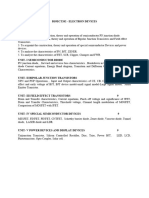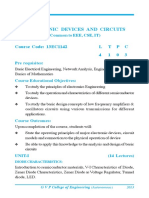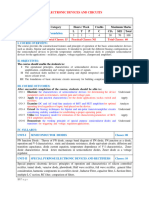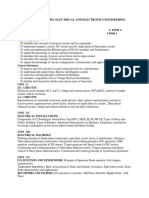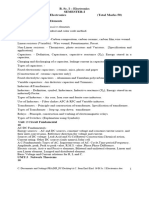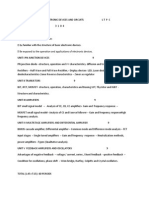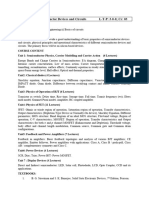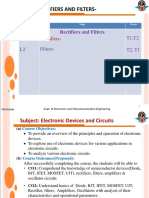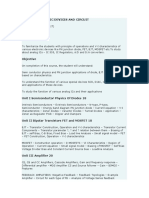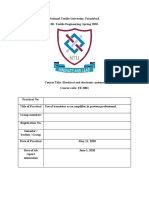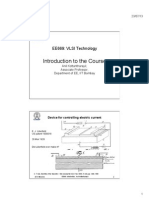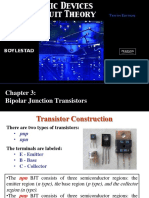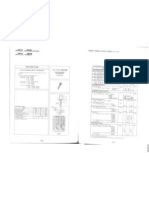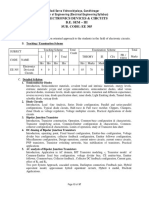0 ratings0% found this document useful (0 votes)
45 viewsElectronic Devices L T P C 3 0 0 3
Electronic Devices L T P C 3 0 0 3
Uploaded by
kalaiThis document outlines the objectives, units, and outcomes of a course on electronic devices and circuits. The course covers the following topics over 5 units: semiconductor material properties, diode circuits, bipolar junction transistors (BJT), small signal analysis, and field effect transistors (FET). The objectives are to expose students to basic electronic devices and acquaint them with the construction, theory, and operation of diodes, BJTs, and FETs. Upon completing the course, students should be able to explain diode and unijunction transistor characteristics, understand basic semiconductor devices, describe transistor equivalence circuits, and operate diodes, BJTs, and FETs.
Copyright:
© All Rights Reserved
Available Formats
Download as DOC, PDF, TXT or read online from Scribd
Electronic Devices L T P C 3 0 0 3
Electronic Devices L T P C 3 0 0 3
Uploaded by
kalai0 ratings0% found this document useful (0 votes)
45 views2 pagesThis document outlines the objectives, units, and outcomes of a course on electronic devices and circuits. The course covers the following topics over 5 units: semiconductor material properties, diode circuits, bipolar junction transistors (BJT), small signal analysis, and field effect transistors (FET). The objectives are to expose students to basic electronic devices and acquaint them with the construction, theory, and operation of diodes, BJTs, and FETs. Upon completing the course, students should be able to explain diode and unijunction transistor characteristics, understand basic semiconductor devices, describe transistor equivalence circuits, and operate diodes, BJTs, and FETs.
Original Description:
ed syllabus
Original Title
Electronic Devices l t p c 3 0 0 3
Copyright
© © All Rights Reserved
Available Formats
DOC, PDF, TXT or read online from Scribd
Share this document
Did you find this document useful?
Is this content inappropriate?
This document outlines the objectives, units, and outcomes of a course on electronic devices and circuits. The course covers the following topics over 5 units: semiconductor material properties, diode circuits, bipolar junction transistors (BJT), small signal analysis, and field effect transistors (FET). The objectives are to expose students to basic electronic devices and acquaint them with the construction, theory, and operation of diodes, BJTs, and FETs. Upon completing the course, students should be able to explain diode and unijunction transistor characteristics, understand basic semiconductor devices, describe transistor equivalence circuits, and operate diodes, BJTs, and FETs.
Copyright:
© All Rights Reserved
Available Formats
Download as DOC, PDF, TXT or read online from Scribd
Download as doc, pdf, or txt
0 ratings0% found this document useful (0 votes)
45 views2 pagesElectronic Devices L T P C 3 0 0 3
Electronic Devices L T P C 3 0 0 3
Uploaded by
kalaiThis document outlines the objectives, units, and outcomes of a course on electronic devices and circuits. The course covers the following topics over 5 units: semiconductor material properties, diode circuits, bipolar junction transistors (BJT), small signal analysis, and field effect transistors (FET). The objectives are to expose students to basic electronic devices and acquaint them with the construction, theory, and operation of diodes, BJTs, and FETs. Upon completing the course, students should be able to explain diode and unijunction transistor characteristics, understand basic semiconductor devices, describe transistor equivalence circuits, and operate diodes, BJTs, and FETs.
Copyright:
© All Rights Reserved
Available Formats
Download as DOC, PDF, TXT or read online from Scribd
Download as doc, pdf, or txt
You are on page 1of 2
19EC102 ELECTRONIC DEVICES AND CIRCUITS LTPC
3003
OBJECTIVES:
To get exposed about basic electronic devices
To acquaint the students with the construction, theory and operation of the
basic electronic devices such as PN junction diode, Bipolar and Field effect
Transistors.
Unit-1 Semiconductor Material Properties: [9]
Elemental & compound semiconductor materials , Bonding forces and Energy bands in
intrinsic and extrinsic silicon, Charge carrier in semiconductors , carrier concentration,
Junction properties, Equilibrium condition, biased junction, Steady state condition,
breakdown mechanism (Rectifying Diodes, Zener Diodes), Metal Semiconductor Junction.
Special diodes: Metal-Semiconductor Junction- MESFET, FINFET, PINFET, CNTFET, DUAL GATE
MOSFET, PN Junction diode-Schottky barrier diode-Zener diode-Varactor diode –Tunnel
diode- Gallium Arsenide device, LASER diode, LDR
Unit-2 Diode circuits: [9]
Ideal and Practical diode, Clipper, Clamper. Power Supply: Rectifiers-Half wave, Full wave,
Bridge rectifier, filter circuits, Voltage regulation using shunt & series regulator circuits,
Voltage regulation using IC.
Unit-3 Fundamentals of BJT: [9]
Construction, basic operation, current components and equations,CB, CE and CC
configuration, input and output characteristics, Early effect, Region of operations: active, cut-
off and saturation region. BJT as an amplifier. Ebers-Moll model, Power dissipation in
transistor (Pd, max rating), Photo transistor. Transistor biasing circuits and analysis:
Introduction, various biasing methods: Fixed bias,Self bias, Voltage Divider bias, Collector to
base bias, Load-line analysis: DC and AC analysis, Operating Point and Bias Stabilization and
Thermal Runaway. Transistor as a switch.
Unit-4 Small Signal analysis: [9]
Small signal Amplifier,Amplifier Bandwidth, Hybrid model, analysis of transistor amplifier
using h-parameter, Multistage Amplifier: Cascading amplifier, Boot-strapping Technique,
Darlington amplifier and cas-code amplifier, Coupling methods in multistage amplifier, Low
and high frequency response, Hybrid πmodel, Current Mirror circuits. Large Signal analysis
and Power Amplifiers: Class A,Class B,Class AB, Class C, Class D, Transformer coupled and
Push-Pull amplifier.
Unit-5 FET construction: [9]
JFET: Construction, n-channel and p-channel, transfer and drain characteristics, parameters,
Equivalent model and voltage gain, analysis of FET in CG, CS and CD configuration.
Enhancement and Depletion MOSFET drain and transfer Characteristics. Unijunction
Transistor (UJT)
OUTCOMES:
At the end of the course, the student should be able to:
Explain the V-I characteristic of diode, UJT
Gain knowledge on basic semiconductor devices
Describe the equivalence circuits of transistors
Operate the basic electronic devices such as PN junction diode, Bipolar
and Field effect Transistors
TEXT BOOKS:
1. William H. Hayt, Jr. Jack E. Kemmerly and Steven M. Durbin,
―Engineering Circuit Analysis‖ , McGraw Hill Science Engineering, Eighth
Edition, 11th Reprint 2016.
2. Joseph Edminister and Mahmood Nahvi, ―Electric Circuits‖, Schaum’s
Outline Series, Tata McGraw Hill Publishing Company, New Delhi, Fifth
Edition Reprint 2016.
3. Donald A Neaman, “Semiconductor Physics and Devices”, Third Edition,
Tata Mc GrawHill Inc.2007
REFERENCES:
1. Charles K. Alexander, Mathew N.O. Sadiku, ―Fundamentals of Electric
Circuits‖, Fifth Edition, McGraw Hill, 9th Reprint 2015.
2. A.Bruce Carlson, ―Cicuits: Engineering Concepts and Analysis of Linear
Electric Circuits‖, Cengage Learning, India Edition 2nd Indian Reprint
2009.
3. Allan H.Robbins, Wilhelm C.Miller, ―Circuit Analysis Theory and
Practice‖, Cengage Learning, Fifth Edition, 1st Indian Reprint 2013.
You might also like
- Course Objecti Ves:: Semiconductor TheoryDocument1 pageCourse Objecti Ves:: Semiconductor TheoryEngr Suleman MemonNo ratings yet
- EEET 205 Lab - 102Document53 pagesEEET 205 Lab - 102Franch Maverick Arellano LorillaNo ratings yet
- Control SystemDocument2 pagesControl SystempriscillaNo ratings yet
- Ec8252 SyllabusDocument1 pageEc8252 SyllabusSarika AyyathuraiNo ratings yet
- EIE101R01 SyllabusDocument3 pagesEIE101R01 Syllabusrithishssrvspmcbse1No ratings yet
- ED Syllabus 23-24Document3 pagesED Syllabus 23-24Geetha MNo ratings yet
- Electronic Devices and Circuits: Andhra Pradesh, IndiaDocument5 pagesElectronic Devices and Circuits: Andhra Pradesh, Indiak jayaram kumar ACETNo ratings yet
- Edc PDFDocument3 pagesEdc PDFChandu L YNo ratings yet
- Electronic Devices and Circuits: Course Code: 13EC1142 L TPC 4 1 0 3Document3 pagesElectronic Devices and Circuits: Course Code: 13EC1142 L TPC 4 1 0 3Vishnu vardhan gurralaNo ratings yet
- Diploma Basic ElectronicsDocument4 pagesDiploma Basic ElectronicsKani MozhiNo ratings yet
- Electronic Devices and CircuitsDocument3 pagesElectronic Devices and Circuitsrohitkumar2022rohitkumarNo ratings yet
- BEEE Mech SyllabusDocument2 pagesBEEE Mech SyllabusSATHISH MOTHENo ratings yet
- Syllabus EC-202Document2 pagesSyllabus EC-202gopinath raoNo ratings yet
- EEE1001 - ELECTRIC-CIRCUITS-AND-SYSTEMS - LTP - 1.2 - 18 - Electric Circuits and SystemsDocument2 pagesEEE1001 - ELECTRIC-CIRCUITS-AND-SYSTEMS - LTP - 1.2 - 18 - Electric Circuits and Systemssatendrasinghparihar340No ratings yet
- Electronics Engineering SyllabusDocument1 pageElectronics Engineering Syllabuspcjoshi02No ratings yet
- Ec6202 Electronic Devices and Circuits SyllabusDocument3 pagesEc6202 Electronic Devices and Circuits SyllabusBabuKannanNo ratings yet
- JNTUA College of Engineering (Autonomous), Ananthapuramu Department of Computer Science & EngineeringDocument4 pagesJNTUA College of Engineering (Autonomous), Ananthapuramu Department of Computer Science & EngineeringManishaNo ratings yet
- EEE1001 - ELECTRIC-CIRCUITS-AND-SYSTEMS - LTP - 1.3 - 53 - EEE1001 - Electric Circuits and Systems - LTP - 4 - V1.3Document2 pagesEEE1001 - ELECTRIC-CIRCUITS-AND-SYSTEMS - LTP - 1.3 - 53 - EEE1001 - Electric Circuits and Systems - LTP - 4 - V1.3devmewada2505No ratings yet
- B.sc. I ElectronicsDocument6 pagesB.sc. I ElectronicsitsquitenNo ratings yet
- Ece131 SyDocument2 pagesEce131 SySmita Rani SatapathyNo ratings yet
- Syllabus EceDocument85 pagesSyllabus EceHemanthNo ratings yet
- A7401 SyllabusDocument2 pagesA7401 SyllabusShashi SagarNo ratings yet
- Ec1x11 Electron Devices and Circuits3 0 2 100Document2 pagesEc1x11 Electron Devices and Circuits3 0 2 100Siva KumarNo ratings yet
- 24EC101Document3 pages24EC10123102208No ratings yet
- Basic Electronics 2nd SemkjjjDocument3 pagesBasic Electronics 2nd SemkjjjSASWATA DASGUPTANo ratings yet
- Unit - I: Instruction 4 Periods Per Week 3 Hours Univ. Exam 75 Marks Sessionals 25 MarksDocument2 pagesUnit - I: Instruction 4 Periods Per Week 3 Hours Univ. Exam 75 Marks Sessionals 25 MarksAfshan KaleemNo ratings yet
- Sir Parshurambhau College, Pune (Autonomous) : Shikshana Prasaraka Mandali'sDocument13 pagesSir Parshurambhau College, Pune (Autonomous) : Shikshana Prasaraka Mandali'sprashantsheetalNo ratings yet
- Edc MaterialDocument2 pagesEdc MaterialSasithar JaisankaranNo ratings yet
- EE SyllabusDocument95 pagesEE Syllabusvikram patilNo ratings yet
- Model Question Bank - EDCDocument12 pagesModel Question Bank - EDCsangeetadineshNo ratings yet
- Electrical Engineering Paper I 1. Electro-Magnetic CircuitsDocument4 pagesElectrical Engineering Paper I 1. Electro-Magnetic CircuitsRomario OinamNo ratings yet
- Iare - Ece - Edc Notes PDFDocument223 pagesIare - Ece - Edc Notes PDFVamshi Krishna0% (1)
- SyllabusDocument2 pagesSyllabusjuniorteamlead.fresourcesNo ratings yet
- Concepts of EEE (CS)Document8 pagesConcepts of EEE (CS)Vikram RaoNo ratings yet
- DEMODocument2 pagesDEMOShaik Abdul RaqeebNo ratings yet
- National Institute of Technology, Srinagar Electrical EngineeringDocument33 pagesNational Institute of Technology, Srinagar Electrical Engineeringzahir khNo ratings yet
- 5basic Electrical and Electronics EngineeringDocument2 pages5basic Electrical and Electronics Engineeringpurushotham1982No ratings yet
- Shri G. S. Institute of Technology & Science: Department of Electronics and InstrumentationDocument4 pagesShri G. S. Institute of Technology & Science: Department of Electronics and Instrumentationakash mishra0% (1)
- Ec 2Document2 pagesEc 2alzahraa1994aliNo ratings yet
- Ec8353 Syllabuselectron Devices and Circuits SyllabusDocument2 pagesEc8353 Syllabuselectron Devices and Circuits SyllabusDhamu DharanNo ratings yet
- Edc SyllabusDocument1 pageEdc SyllabusHathiram NenavathNo ratings yet
- Anurag Engineering College: I Iyear B.Tech. Eee - I Sem L T/P/D C 3 1/-/-3Document6 pagesAnurag Engineering College: I Iyear B.Tech. Eee - I Sem L T/P/D C 3 1/-/-3Anonymous M4VY7LsXNo ratings yet
- Beee SyllabusDocument3 pagesBeee SyllabusHarshajit BoseNo ratings yet
- Ec8351 Electronic Circuits IDocument2 pagesEc8351 Electronic Circuits IOral RobertzNo ratings yet
- JNTUK DAP Course Structure and Syllabus EEE II YEAR R10 Students 3Document32 pagesJNTUK DAP Course Structure and Syllabus EEE II YEAR R10 Students 3Shravan RaoNo ratings yet
- BE8255 r17 Basic Electrical Electronics and Measurement EnggDocument2 pagesBE8255 r17 Basic Electrical Electronics and Measurement EnggK.Swetha PriyadharshiniNo ratings yet
- Ece1002 Fundamentals-Of-Electrical-And-Electronics-Engineering Ela 2.0 5 Ece1002 Feee 2.0Document3 pagesEce1002 Fundamentals-Of-Electrical-And-Electronics-Engineering Ela 2.0 5 Ece1002 Feee 2.0gorijavolukaveri18No ratings yet
- Analog& Digital Electronics R-20Document148 pagesAnalog& Digital Electronics R-20KEPHA NGIGINo ratings yet
- BSC Electronics Syllabus Kerala UniversityDocument64 pagesBSC Electronics Syllabus Kerala UniversityVarunRaj67% (3)
- EEE 231 CoursecontentDocument3 pagesEEE 231 Coursecontentfakiha11No ratings yet
- Electronics-I Course Riphah UniversityDocument1 pageElectronics-I Course Riphah Universityawais tabassumNo ratings yet
- (I-I) Bee Theory SyllabusDocument2 pages(I-I) Bee Theory Syllabuscharanreddy91234No ratings yet
- Ece1002 Semiconductor-Devices-And-Circuits Eth 2.1 47 Ece1002 PDFDocument2 pagesEce1002 Semiconductor-Devices-And-Circuits Eth 2.1 47 Ece1002 PDFDeepak SomiNo ratings yet
- 3Document5 pages3eee.hodNo ratings yet
- EDCunit 1Document55 pagesEDCunit 1Shiva NSNo ratings yet
- 60 EE 001Document1 page60 EE 001gshivamihit2808No ratings yet
- Ec2111 Electronic Devices and CircuitDocument3 pagesEc2111 Electronic Devices and CircuitarunfriendsNo ratings yet
- Beee SylDocument2 pagesBeee SyltanniruvarshithaNo ratings yet
- Power Electronics and Energy Conversion Systems, Fundamentals and Hard-switching ConvertersFrom EverandPower Electronics and Energy Conversion Systems, Fundamentals and Hard-switching ConvertersNo ratings yet
- SC2634Document4 pagesSC2634srirsdeoNo ratings yet
- XII Physics Question Bank 2024Document14 pagesXII Physics Question Bank 2024hussain900502No ratings yet
- 2007-08 M.sc. ElectronicsDocument19 pages2007-08 M.sc. ElectronicsUlhasNo ratings yet
- SilvacoDocument13 pagesSilvacoRajesh AgarwalNo ratings yet
- EE LAbDocument14 pagesEE LAbMaida IrshadNo ratings yet
- Physical Handout NotesDocument121 pagesPhysical Handout NotesJimmy MachariaNo ratings yet
- AE - 1.3b Frequency Response of CE Amplifier, Three Frequency BandsDocument38 pagesAE - 1.3b Frequency Response of CE Amplifier, Three Frequency BandsjayanthiNo ratings yet
- Ragini 2Document56 pagesRagini 2Ragini GudelliNo ratings yet
- Introduction To The Course: EE669: VLSI TechnologyDocument20 pagesIntroduction To The Course: EE669: VLSI TechnologyPraveen VsNo ratings yet
- Eee-III-Analog Electronic Ckts (10es32) - SolutionDocument99 pagesEee-III-Analog Electronic Ckts (10es32) - SolutionSatya NarayanaNo ratings yet
- Physics of Semiconductor 23-24 Term 1Document2 pagesPhysics of Semiconductor 23-24 Term 1Tini07 PakpahanNo ratings yet
- c945 Data SheetDocument2 pagesc945 Data SheetAdnan AliNo ratings yet
- Assignment 4Document7 pagesAssignment 4Niraj Prasad YadavNo ratings yet
- BJ - Cable Type - EN - TCD210042AA - CATALOG - WDocument2 pagesBJ - Cable Type - EN - TCD210042AA - CATALOG - WJORGE RODNo ratings yet
- C5406 PanasonicDocument2 pagesC5406 PanasonicHernan Ortiz EnamoradoNo ratings yet
- TC Syllabus OverallDocument158 pagesTC Syllabus OverallVaishnavi SrinathNo ratings yet
- Ed - 2022 - Chap 03Document126 pagesEd - 2022 - Chap 03Đăng Trần QuốcNo ratings yet
- RT1N436C TP 1Document3 pagesRT1N436C TP 1Galan BelloNo ratings yet
- Viva QuestionsDocument11 pagesViva QuestionsRaj Kumar0% (1)
- Ee105 Fet LectDocument61 pagesEe105 Fet LectKahMun LimNo ratings yet
- Electronics Syllabus 18-21Document17 pagesElectronics Syllabus 18-21BlessingNo ratings yet
- Nand TTLDocument8 pagesNand TTLAnas SadiqNo ratings yet
- Vijay Maurya ADE TutorialDocument4 pagesVijay Maurya ADE TutorialKshitij JaiswalNo ratings yet
- 2 N 4957Document5 pages2 N 4957Marco Eduardo Zambrano MatuteNo ratings yet
- Group 8 - Final RequirementDocument50 pagesGroup 8 - Final RequirementJERUSHA ANNE RETARDONo ratings yet
- Plastic Medium Power NPN Silicon Transistor BD159: ON SemiconductorDocument5 pagesPlastic Medium Power NPN Silicon Transistor BD159: ON Semiconductormy3160No ratings yet
- EE305 - Electronics Devices and CircuitsDocument4 pagesEE305 - Electronics Devices and CircuitsBALAKRISHNANNo ratings yet
- bc327 328Document2 pagesbc327 328marcelo giussaniNo ratings yet
- Bipolar Junction Transistor CharacteristicsDocument5 pagesBipolar Junction Transistor CharacteristicsKrishnaveni Subramani SNo ratings yet





